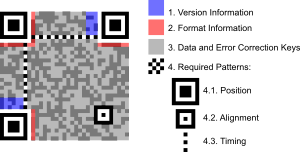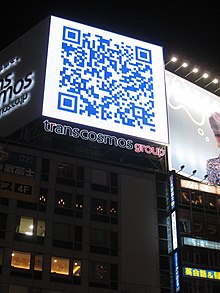QR code: Difference between revisions
Buffavento (talk | contribs) No edit summary |
|||
| Line 83: | Line 83: | ||
Generating QR codes is slowly moving into the mainstream in America as well. There are numerous internet platforms which allow users to create and manage QR codes. Many generating platforms will also allow users to view analytics on how and when the code is being scanned. |
Generating QR codes is slowly moving into the mainstream in America as well. There are numerous internet platforms which allow users to create and manage QR codes. Many generating platforms will also allow users to view analytics on how and when the code is being scanned. |
||
You can create QR codes using with http://www.qrcodegen.com website. |
|||
== Bibliography == |
== Bibliography == |
||
| Line 108: | Line 110: | ||
{{Commons category|QR code}} |
{{Commons category|QR code}} |
||
*[http://www.denso-wave.com/qrcode/index-e.html '''QR Code''' - Official website] by QR Code's creator [[Denso|Denso-Wave]]. |
*[http://www.denso-wave.com/qrcode/index-e.html '''QR Code''' - Official website] by QR Code's creator [[Denso|Denso-Wave]]. |
||
*You can create QR codes using with http://www.qrcodegen.com website. |
|||
<!-- Do NOT add links to external sites which generate QR Codes, or provide QR solutions. Wikipedia is not a directory of links. If you really believe you have something to link which is utterly unique, please bring it up on the discussion page. --> |
<!-- Do NOT add links to external sites which generate QR Codes, or provide QR solutions. Wikipedia is not a directory of links. If you really believe you have something to link which is utterly unique, please bring it up on the discussion page. --> |
||
Revision as of 21:36, 9 August 2010

A QR Code is a matrix barcode (or two-dimensional code), readable by QR scanners, mobiles phones with camera, and smartphones. The code consists of black modules arranged in a square pattern on white background. The information encoded can be text, URL or other data.
Common in Japan, where it was created by Japanese corporation Denso-Wave in 1994, the QR code is one of the most popular types of two-dimensional barcodes. QR is the initialism of Quick Response, as the creator intended the code to allow its contents to be decoded at high speed.[1]
Overview

Although initially used for tracking parts in vehicle manufacturing, QR Codes are now used in a much broader context, including both commercial tracking applications and convenience-oriented applications aimed at mobile phone users (known as mobile tagging).
QR Codes storing addresses and URLs may appear in magazines, on signs, buses, business cards, or on just about any object that users might need information about. Users with a camera phone equipped with the correct reader application can scan the image of the QR Code to display text, contact information, connect to a wireless network, or open a web page in the phone's browser. This act of linking from physical world objects is known as a hardlink or physical world hyperlinks. Google's mobile Android operating system supports the use of QR codes by natively including the barcode scanner (ZXing) on some models and the browser supports URI redirection, which allows QR Codes to send metadata to existing applications on the device. Nokia's Symbian operating system is also provided with a barcode scanner, which is able to read QR Codes [citation needed], while mbarcode [2] is a QR code reader for the Maemo operating system.
Users can also generate and print their own QR Code for others to scan and use by visiting one of several free QR Code generating sites.
Standards

There are several standards documents covering the physical encoding of QR Code:[3]
- October 1997 — AIM International[4]
- January 1999 — JIS X 0510
- June 2000 — ISO/IEC 18004:2000 Information technology — Automatic identification and data capture techniques — Bar code symbology — QR Code (now withdrawn)
Defines QR Code Model 1 and QR Code Model 2 symbols. - 1 September 2006 — ISO/IEC 18004:2006 Information technology — Automatic identification and data capture techniques — QR Code 2005 bar code symbology specification
Defines QR Code 2005 symbols, an extension of QR Code Model 2. Does not specify how to read QR Code Model 1 symbols, or require this for compliance.
At the application layer, there is some variation between implementations. NTT DoCoMo has established de facto standards for the encoding of URLs, contact information, and several other data types.[5] The open-source "ZXing" project maintains a list of QR Code data types.[6]
License
The use of the QR Code is free of any license. The QR Code is clearly defined and published as ISO standard. Denso Wave owns the patent rights on QR Code, but has chosen not to exercise them.[3]
The term QR Code itself is a registered trademark of Denso Wave Incorporated.[7]
Storage
| QR Code data capacity[1] | |
|---|---|
| Numeric only | Max. 7,089 characters |
| Alphanumeric | Max. 4,296 characters |
| Binary (8 bits) | Max. 2,953 bytes |
| Kanji/Kana | Max. 1,817 characters |
| Error correction capacity | |
|---|---|
| Level L | 7% of codewords can be restored. |
| Level M | 15% of codewords can be restored. |
| Level Q | 25% of codewords can be restored. |
| Level H | 30% of codewords can be restored. |
QR codes use the Reed–Solomon error correction.
Variants

Micro QR Code is a smaller version of the QR Code standard for applications with less ability to handle large scans. There are different forms of Micro QR Code as well. The highest of these can hold 35 characters.
Design QR is a QR Code that was optimized to include a picture or logo to enhance conversion rates. [8]
Use as artwork
Since 2006 the Italian artist Fabrice de Nola uses QR codes in oil paintings or embedded in photographs.[9]
In 2007 the British pop group Pet Shop Boys used QR code for the artwork of their download-only single Integral. The videoclip for the song also features QR code. When the codes are scanned, users are directed to the Pet Shop Boys website, and web pages about the British national identity card plans, respectively.
In 2009 the Japanese artist Takashi Murakami, in collaboration with creative agency SET and Louis Vuitton, created a design QR featuring the LV pattern and one of the artist’s characters.[10]
In 2010 the musician and artist DJ Spooky used QR code in a fine art print exhibited at Experimenta Biennale, Melbourne. Scanning the code takes users to an experiential web based artwork called the Nauru Ellegies,[11] about the complexities of the South Pacific island of Nauru.
A QR code which scans to produce the word "LOVE" was also featured prominently in Australian artist Kylie Minogue's music video for her 2010 single All The Lovers.
In June 2010, the Design Exchange, Canada's National Design Centre, unveiled a large QR installed created by Rollout Wallpaper. Rollout Wallpaper is a custom wallpaper company operating in Vancouver. The installation is part of the 'Bent Out of Shape' exhibit, curated by Design Exchange staff.
Standalone Applications
While the adoption of QR codes in some markets, including the United States, has been slow to take off, the technology is gaining some traction in the smartphone market. Many Android phones come with QR code readers already installed. Blackberry phones running Blackberry Messenger 5.0 (or more recent versions) can also scan QR codes using the "Scan A Group Barcode" option in the BBM menu. Both the Android Market and the iTunes App Store offer several free applications that can decode QR matrices.
Generating QR codes is slowly moving into the mainstream in America as well. There are numerous internet platforms which allow users to create and manage QR codes. Many generating platforms will also allow users to view analytics on how and when the code is being scanned.
You can create QR codes using with http://www.qrcodegen.com website.
Bibliography
- Information technology. Automatic identification and data capture techniques. Bar code symbology. QR code. Geneva, ISO/IEC, 2000, pp 114. OCLC 60816353.[12]
- Information technology. Automatic identification and data capture techniques. QR Code 2005 bar code symbology specification. London, BSI, 2007, pp 126.[13] ISBN 9780580673689
See also
References
- ^ a b About 2D Code | QR Code.com Denso-Wave. Retrieved 2009-04-23.
- ^ "package overview for mbarcode". Maemo.org. Retrieved 2010-07-28.
- ^ a b "QR Code Standardization | QR Code.com". Denso-wave.com. Retrieved 2009-04-23.
- ^ "AIM GLOBAL Online Store". Aimglobal.org. Retrieved 2009-04-23.
- ^ "Synchronization with Native Applications". NTT docomo. Retrieved 17 February 2009.
- ^ "Barcode Contents". zxing – A rough guide to standard encoding of information in barcodes. Retrieved 17 February 2009.
- ^ "QR Code.com". Denso-wave.com. 2003-11-06. Retrieved 2009-04-23.
- ^ "design QR | d-qr.net". IT DeSign Inc. Retrieved 2009-11-19.
- ^ Fabrice de Nola at Mediamorfosi - Sud Lab Template:It. Retrieved 2010-07-25.
- ^ Designer QR Codes: Beyond Black and White. The Murakami-inspired Louis Vuitton QR code. «Creativity», April 29, 2009. Retrieved 2010-07-25.
- ^ DJ Spooky - Nauru Elegies Retrieved 2010-07-25.
- ^ File card at WorldCat. Retrieved 2010-07-26.
- ^ BS ISO/IEC 18004:2006 - File card. Retrieved 2010-07-26.
External links
- QR Code - Official website by QR Code's creator Denso-Wave.
- You can create QR codes using with http://www.qrcodegen.com website.


